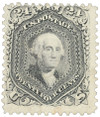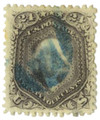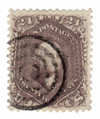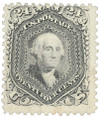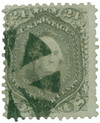
# 78 - 1862 24c Washington, lilac
U.S. #78
1862 George Washington
- Exists in various shades
- Paid the letter rate to England
Stamp Category: Definitive
Series: 1861-66 Issue
Value: 24c
Earliest Documented Use: October 23, 1862
Printed by: National Bank Note Co.
Quantity printed: 9,620,000 (estimate)
Format: Printed in sheets of 200 stamps, divided into vertical panes of 100 each
Printing Method: Engraving
Perforations: 12
Color: Lilac
Why the stamp was issued: The stamp paid the treaty rate on letters traveling to England.
About the printing: The design was engraved on a die – a small, flat piece of steel. The design was copied to a transfer roll – a blank roll of steel. Several impressions or “reliefs” were made on the roll. The reliefs were transferred to the plate – a large, flat piece of steel from which the stamps were printed.
All shades of this stamp were printed with the same plate. They include minor varieties: grayish lilac (#78a), gray (#78b) and blackish violet (#78c) plus dark lilac (no Scott number).
About the design: The image of Washington is based on a portrait by renowned artist Gilbert Stuart. Stuart painted at least 100 portraits of Washington.
Special design details: Well-centered examples of the stamp are hard to find and command premium prices.
About the 1861-66 Series: The series consists of US #73, and 75-78. The 3c scarlet value, formerly #74, has been reassigned to the Trial Color Proof category of the Scott Specialized Catalogue of United States Stamps and Covers.
The 5c Jefferson and 24c Washington stamps had the same face values as those demonetized at the beginning of the Civil War. New to the line-up were the 2c Jackson, needed for the increased postal rate, and the 15c Lincoln stamp. The frame designs vary greatly from the Series of 1857-61. The denominations were not only written out, but were also shown in numerals displayed in the upper corners of the stamps. This helped distinguish them from the demonetized series, which could no longer be used. The 15c Lincoln stamp was the first presidential “mourning” stamp. Issued one year after Lincoln’s assassination, it was also the first 15c U.S. stamp, paying the single rate to France.
History the stamp represents: Due to the outbreak of the Civil War, all US stamps were demonetized and declared invalid for postage. This prevented the Confederate States of America (CSA) from selling them and using the money to support the Southern war effort.
The new stamps were sent to post offices along with a notice that required an exchange period of six days be announced in local newspapers. During the exchange period, old stamps could be exchanged for new ones. After the six-day exchange period, the old stamps were no longer accepted as postage.
U.S. #78
1862 George Washington
- Exists in various shades
- Paid the letter rate to England
Stamp Category: Definitive
Series: 1861-66 Issue
Value: 24c
Earliest Documented Use: October 23, 1862
Printed by: National Bank Note Co.
Quantity printed: 9,620,000 (estimate)
Format: Printed in sheets of 200 stamps, divided into vertical panes of 100 each
Printing Method: Engraving
Perforations: 12
Color: Lilac
Why the stamp was issued: The stamp paid the treaty rate on letters traveling to England.
About the printing: The design was engraved on a die – a small, flat piece of steel. The design was copied to a transfer roll – a blank roll of steel. Several impressions or “reliefs” were made on the roll. The reliefs were transferred to the plate – a large, flat piece of steel from which the stamps were printed.
All shades of this stamp were printed with the same plate. They include minor varieties: grayish lilac (#78a), gray (#78b) and blackish violet (#78c) plus dark lilac (no Scott number).
About the design: The image of Washington is based on a portrait by renowned artist Gilbert Stuart. Stuart painted at least 100 portraits of Washington.
Special design details: Well-centered examples of the stamp are hard to find and command premium prices.
About the 1861-66 Series: The series consists of US #73, and 75-78. The 3c scarlet value, formerly #74, has been reassigned to the Trial Color Proof category of the Scott Specialized Catalogue of United States Stamps and Covers.
The 5c Jefferson and 24c Washington stamps had the same face values as those demonetized at the beginning of the Civil War. New to the line-up were the 2c Jackson, needed for the increased postal rate, and the 15c Lincoln stamp. The frame designs vary greatly from the Series of 1857-61. The denominations were not only written out, but were also shown in numerals displayed in the upper corners of the stamps. This helped distinguish them from the demonetized series, which could no longer be used. The 15c Lincoln stamp was the first presidential “mourning” stamp. Issued one year after Lincoln’s assassination, it was also the first 15c U.S. stamp, paying the single rate to France.
History the stamp represents: Due to the outbreak of the Civil War, all US stamps were demonetized and declared invalid for postage. This prevented the Confederate States of America (CSA) from selling them and using the money to support the Southern war effort.
The new stamps were sent to post offices along with a notice that required an exchange period of six days be announced in local newspapers. During the exchange period, old stamps could be exchanged for new ones. After the six-day exchange period, the old stamps were no longer accepted as postage.



